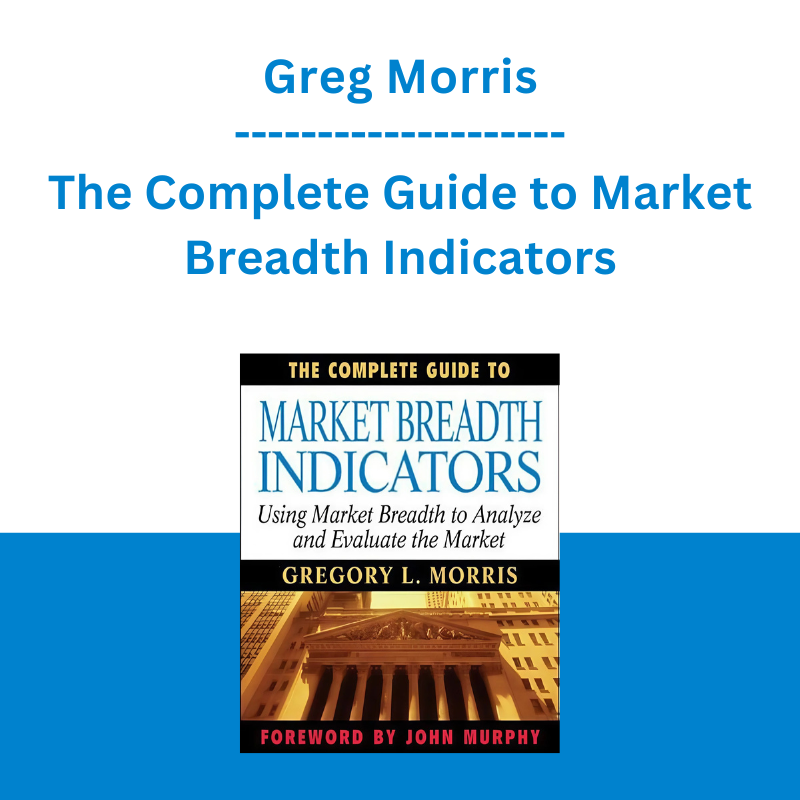*** Proof of Product ***
Exploring the Essential Features of “Greg Morris – The Complete Guide to Market Breadth Indicators: How to Analyze and Evaluate market Direction and Strength”
The Complete Guide to Market Breadth Indicators: How to Analyze and Evaluate market Direction and Strength 1st Edition
by Gregory L. Morris (Author)
Market breadth indicators, i.e. advance/decline, new high/new low, or up/down volume, allow technical analysts and traders to look beneath the surface of a market to quantify the underlying strength or direction associated with a market move. Increasingly popular in all types of markets, they give traders the ability to accurately forecast a number of possible outcomes and the likelihood of each.
Bottom line? For gauging the near-term direction and strength of a market, breadth indicators are among the single most valuable tools a trader can use.
The Complete Guide to Market Breadth Indicators is the most comprehensive and vivid collection available of market breadth indicator information and features ideas and insights from market veterans including John Murphy, Don Beasley, Jim Miekka, Tom and Sherman McClellan, and numerous others. Chapters are first categorized based upon the mathematical relationship between the breadth pairs. Each indicator is then analyzed to provide information including:
- Also known as–other names by which the indicator is recognized
- Author/creator--when available
- Data components required–components of breadth data required to calculate the indicator
- Description–brief description of the indicator
- Interpretation–generally accepted industry interpretation of the indicator, with techniques of different analysts also discussed
- Chart–Chart or charts that best display the indicator
- Author comments–Greg Morris’s personal interpretation, opinion, and use of the indicator, along with suggested modifications, complementary indicators, and more
- Formula–An algebraic formula for the indicator or, for formulae that are too complex for this section, a descriptive narrative on the formula
- References–An indicator-specific bibliography for additional information on the indicator or its creator, with notes about a particular book or magazine articleBreadth analysis is one of the purest measures of market liquidity. Applicable to virtually any exchange or index of securities for which breadth data is available, it represents the best available footprint of the health and near-term direction of the overall market examined. The Complete Guide to Market Breadth Indicators is the first book to delve into the use, mathematics, and interpretation of the most popular and proven of these tools, and is an invaluable reference for technical traders and investors of all types, and in every market.
Editorial Reviews
From the Back Cover
Capsule descriptions of more than 80 leading breadth indicators–what they are, what they mean, and when and how to use each
Praise for The Complete Guide to Market Breadth Indicators:
“This book should be called the Encyclopedia of Market Breadth because it includes every form of market breadth known to man. A must for any serious student of this important and overlooked subject.”
–Martin Pring, Author, Technical Analysis Explained
“In The Complete Guide to Market Breadth Indicators, Greg Morris passes along his many years of experience, describing the market breadth indicators that he finds most effective.”
–Sherman McClellan, Publisher, The McClellan Market Report
“The most comprehensive study of breadth I’ve ever seen. Here, in one place, you get, literally, all the indicators that study the market’s innards. All serious technicians will want this book on their shelves.”
–John Sweeney, Former Technical Editor, Technical Analysis of Stocks & Commodities
“This is clearly the definitive work on breadth. From basic to advanced applications, Greg Morris has included it all in this book–including thoughts on the continuing validity of the data.”
–Larry McMillan, Author of Options as a Strategic Investment, McMillan on Options, and Profit with Options
“Rich in detail yet easy to digest and understand. Greg Morris has left no stone unturned in writing what is clearly the leading resource on stock market breadth.”
–Tim Hayes, CMT, Chief Investment Strategist, Ned Davis Research
“Greg Morris has done a great job of assembling a large variety of indicators based on market breadth data. More importantly, he has illustrated why breadth data is so important to market analysis.”
–Tom McClellan, Editor, The McClellan Market Report
Market breadth indicators, i.e. advance/decline, new high/new low, or up/down volume, allow technical analysts and traders to look beneath the surface of a market to quantify the underlying strength or direction associated with a market move. Increasingly popular in all types of markets, they give traders the ability to accurately forecast a number of possible outcomes and the likelihood of each.
Bottom line? For gauging the near-term direction and strength of a market, breadth indicators are among the single most valuable tools a trader can use.
The Complete Guide to Market Breadth Indicators is the most comprehensive and vivid collection available of market breadth indicator information and features ideas and insights from market veterans including John Murphy, Don Beasley, Jim Miekka, Tom and Sherman McClellan, and numerous others. Chapters are first categorized based upon the mathematical relationship between the breadth pairs. Each indicator is then analyzed to provide information including:
- Also known as–other names by which the indicator is recognized
- Author/creator–when available
- Data components required–components of breadth data required to calculate the indicator
- Description–brief description of the indicator
- Interpretation–generally accepted industry interpretation of the indicator, with techniques of different analysts also discussed
- Chart–Chart or charts that best display the indicator
- Author comments–Greg Morris’s personal interpretation, opinion, and use of the indicator, along with suggested modifications, complementary indicators, and more
- Formula–An algebraic formula for the indicator or, for formulae that are too complex for this section, a descriptive narrative on the formula
- References–An indicator-specific bibliography for additional information on the indicator or its creator, with notes about a particular book or magazine articleBreadth analysis is one of the purest measures of market liquidity. Applicable to virtually any exchange or index of securities for which breadth data is available, it represents the best available footprint of the health and near-term direction of the overall market examined. The Complete Guide to Market Breadth Indicators is the first book to delve into the use, mathematics, and interpretation of the most popular and proven of these tools, and is an invaluable reference for technical traders and investors of all types, and in every market.
About the Author
Gregory L. Morris is a consultant and cofounder and former CEO of MurphyMorris, Inc., which was acquired by StockCharts.com. The developer of candlestick filtering and a globally acknowledged expert and lecturer on candlesticks, Morris wrote the seminal Candlestick Charting Explained and has written a number of investment-related articles. He is a graduate of the Navy Fighter “Top Gun” School and retired in 2004 after twenty-six years as a captain for a major international airline.
Product details
Publisher : McGraw-Hill; 1st edition
Language : English
Hardcover : 304 pages
About the author
Gregory L. Morris
Gregory L Morris currently serves as a senior advisor for McElhenny Sheffield in Dallas, TX. Previously, Morris was Sr. Vice President, Chief Technical Analyst, and Chairman of the Investment Committee for Stadion Money Management, LLC. He also serves as the chairman of the Station Trust Board. In that capacity Greg educated institutional and individual clients on the merits of technical analysis and why Stadion utilizes a technical rules-based model. Greg oversaw the management of over $6 Billion in assets in six mutual funds, separate accounts, and retirement plans. From December, 2003 to May, 2005, Greg served as a Trustee and advisor to the MurphyMorris ETF Fund. He also served as Treasurer and Chief Executive Officer of MurphyMorris Money Management Co, the Advisor to the Fund. Greg currently writes a blog on StockCharts.com called Dancing with the Trend.
Greg has written three books with McGraw-Hill; The Complete Guide to Market Breadth Indicators, a book introducing market breadth analysis for investors, a third edition (original edition in 1992) to his best-selling and vastly expanded Candlestick Charting Explained was released in March, 2006, and Candlestick Charting Explained Workbook, which was published in December, 2011. Greg recently completed his fourth book, “Investing with the Trend – A Rules-based Approach to Money Management” published by John Wiley under the Bloomberg Press label. This is a book about the flaws of modern finance, research on risk and trend analysis, and how to build a rules-based trend following model. In 2011, Greg produced Japanese Candlestick Pattern Recognition software for MetaStock. This is an add-on package that not only offers automatic identification of real patterns, but provides a sophisticated trend analysis measure and automatic support and resistance identification.
Greg was a member of the National Association of Active Investment Managers (NAAIM) where he was chairman of the Wagner Paper Contest, the American Association of Professional Technical Analysts (AAPTA), and the Market Technician’s Association (MTA). During college he was a member of the American Institute of Aeronautics and Astronautics.
From 1996 to 2002, Greg was CEO of MurphyMorris.Inc., the leading provider of web-based market analysis tools, education, and commentary. MurphyMorris, Inc. was acquired by StockCharts.com, Inc. in October, 2002. In 1999, Greg and three associates started MurphyMorris Money Management Co. to manage assets for individuals. This focus was later changed to address the firm becoming the Advisor to the MurphyMorris ETF Fund in January, 2004, and later merged into the Stadion (PMFM) family of funds.
From 1994 to 1996, he was President of G. Morris Corporation, a Dallas, Texas headquartered business that provided products and services for investors and traders. His lead product was a series of over 450 Indicators & Trading Systems that supported most windows-based technical analysis software packages. From 1993 to 1994, Greg was part of MarketArts, Inc. which launched the first windows-based technical analysis software program, Windows on Wall Street.
In 1992 he published a book on Japanese candlestick analysis called CandlePower, now available in soft cover as Candlestick Charting Explained (McGraw-Hill). Widely recognized as an expert on candlesticks and the developer of candlestick filtering, he has lectured around the world on the subject. From 1982 until 1993, he worked in association with N-Squared Computing, producing over 15 technical analysis and charting software titles, many of which are actively used today. In May, 1989, he was awarded outstanding alumni for 1989 from Pratt County College.
Greg earned his pilot’s license in 1967 and flew many versions of Cessna (Cessna 150 maximum takeoff weight = 1,500 pounds) and Mooney single-engine aircraft. During his 7 years as a Navy pilot he flew the T2-C Buckeye, A-4J Skyhawk, and his favorite military jet, the F-4J Phantom. While in the Navy, he logged over 240 carrier landings (103 at night) and exceeded twice the speed of sound. From 1978 to his retirement in 2004, Greg was a Captain for Delta Air Lines flying the Boeing 727, Lockheed L-1011, McDonald Douglas MD-88, MD-90, Boeing 757, Boeing 767, and his favorite airliner, the McDonald Douglas MD-11 (maximum takeoff weight = 625,000 pounds). With his private pilot time, the Navy fighter pilot career (1971 – 1978), and airline career he accumulated 21,000 hours of flying time, and as he likes to say, never put a scratch on an airplane.
He graduated from the University of Texas at Austin in 1971, has a BS degree in Aerospace Engineering, has authored numerous investment-related articles, speaks at numerous seminars and investment groups, appeared many times on Financial News Network (FNN), Fox Business, CNBC, and Bloomberg TV. Greg was featured in Investor’s Business Daily in December, 2007, Business Week in July 2008, Barron’s in January, 2009, Stocks and Commodities in September, 2009, and Bloomberg Markets in May, 2011. Greg has been invited to Italy, Brazil, Vietnam, Canada, Hong Kong, Singapore, and China to lecture on the merits of technical market analysis. From 1971 to 1977, he was a Navy F-4 fighter pilot aboard USS Independence who was selected for, and graduated from, the Navy Fighter Weapons School known as Top Gun. Greg and his wife, Laura, live in McKinney, Texas.
Customer reviews
Wayne
The bible of Market Breadth !
I had previously borrowed this from the library, loved it so much, I bought it. You do need to be a bit of a metrics nerd, but if you want the bible of market breadth… this is it ! Every volume based indicator you can think of, and many, many more !
Please see the full list of alternative group-buy courses available here: https://lunacourse.com/shop/









